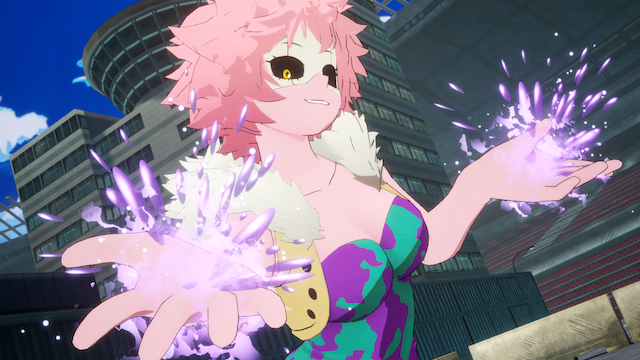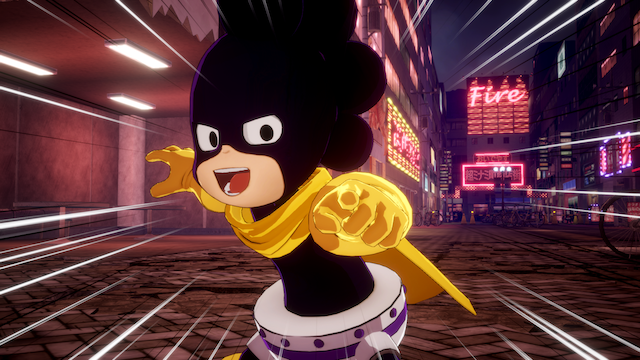How do you judge whether a sequel is successful? Do you strip all context away from the game, judging it on its own merits and while resisting to compare it to its predecessors? Or do you take a more circumspect view, judging from the position that, to be successful, a sequel must go above and beyond what came before?
This is not a rhetorical question, this is something you should think about right now, because your answer to that question will greatly affect what you think of My Hero One’s Justice 2.
My Hero One’s Justice 2 Review: Go Beyond?

My Hero One’s Justice 2 is about as direct of a sequel as you’re ever bound to see. All of the characters from the original game return, along with a handful of new fighters including fan favorites like Mina Ashido and Nejire Hado. There are also some unexpected-but-welcome additions in Kendo Rappa and Twice.
The story follows the anime, picking up right where My Hero One’s Justice left off. This means that if you’re looking to pick up this game as an entry point into the world of My Hero Academia, you should look elsewhere. This game works best, and makes the most sense, if you view it as more of a companion piece to the anime and manga.
If you jump right into My Hero One’s Justice 2 without getting caught up on the series, you’ll have a lot of moments spoiled for you — and worse yet, they’ll be spoiled for you in ways that lack the emotional weight that the anime and manga carry.
Having said that, if you’re all caught up, there’s no need to play My Hero One’s Justice 1 unless you’re a huge fan of early-season My Hero Academia storylines. You’re not really missing anything.
New Quirks

If you’ve played the original, the story mode in My Hero One’s Justice 2 will be very familiar to you. You’ll play through the story of the show, first from the hero perspective and then from the villain perspective, recreating iconic battles and moments, while also satisfying additional requirements thqt unlock customization items you can slap on your favorite heroes and villains. Nothing much new there.
Arcade mode is also baked into the actual game this time around, whereas it was added in a Day One update in the original.
The only truly fresh game mode here is the mission mode, which is an oddly engaging blend of management simulator, survival mode, and board game. You’ll pay in-game currency to recruit heroes and villains, and then use them to battle your way across a game board on one health bar, collecting recovery items and leveling your characters up as you go.
The conceit of the mission mode is that you’re running your own hero agency, and at its best, it actually kind of feels that way. I would have loved, however, for the mission mode to be more fleshed out, to have more of a story-based throughline than just picking a board to clear out, especially since it’s one of the only truly new things about the title.
Sequelitis

For better or worse, depending on how you feel, there’s not a lot here that differentiates My Hero 2 from the original in terms of gameplay and mechanics. Most of the changes will go unnoticed, even by folks who played the original.
Now, in my view, that’s for the best in a lot of ways.
My Hero One’s Justice was a fun game, but it lacked a few key quality-of-life mechanics that are necessary for 3D arena fighters. Notably, My Hero One’s Justice 2 adds a function that allows for dashing out of guard, making projectile spam a whole lot easier to deal with. It also has a block meter.
Guarding and movement also seem a whole lot more responsive and less slippery. They’re the kind of things that seem so second-nature that I almost forgot they weren’t in the original game. The effects of these tiny changes are far-reaching, however, in the way they dictate battles. Fights are more dynamic and quicker now, with fewer opportunities for characters to get stuck in guard lock.
The game also addressed one of my biggest issues with My Hero One’s Justice by giving more weight to quirks. New visual effects help differentiate characters, and many characters now have unique gimmicks based on their quirks, like Sir Nighteye’s foresight that lets you see what your opponent will do before they do it, and Mina Ashido’s breakdancing-and-acid-spraying-attacks doing corrosive damage over time.
A big part of the show’s appeal is in seeing these characters use their own unique abilities to find creative solutions to problems, and My Hero One’s Justice 2 captures some of that spark.
My Hero One’s Justice 2 Review — The Bottom Line

Pros
- Thanks to guard meters and guard cancels, battles are more dynamic
- Quirks are more quirky
- The expanded character roster mixes expected additions with more obscure fan favorites
- Mina Ashido is in this one
Cons
- Very, very similar to My Hero One’s Justice 1
- Small, incremental changes aren’t sexy
- The mission mode begs to be expanded with some sort of overarching narrative
The enjoyment you’ll get out of this game is directly tied to how much you enjoy the series it’s based on. Will you be happy with a fighting game that’s marginally better than the still-pretty-good fighting game launched back in 2018? Or will the fact that the game didn’t take enough chances, enough big steps forward frustrate you?
Make no mistake, My Hero One’s Justice 2 is a good, fun arena brawler on its own merits. Taken on its own, the game really does provide an amazing adaptation of the My Hero Academia franchise. The look is spot on, the expanded character roster is a treat, and the incremental changes the developers made really do make a difference, even if they’re hard to see sometimes.
[Note: A copy of My Hero One’s Justice 2 was provided by Bandai Namco for the purpose of this review.]






Published: Mar 19, 2020 08:38 pm